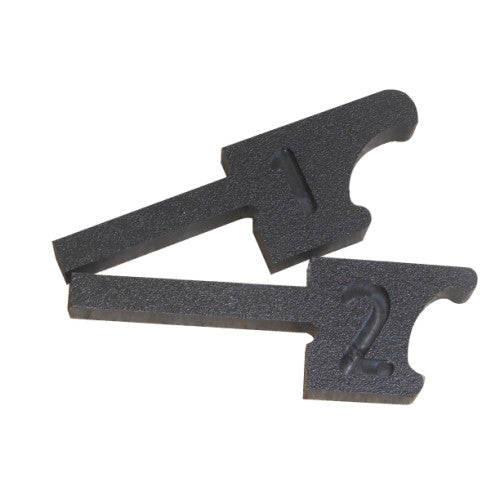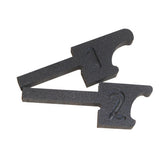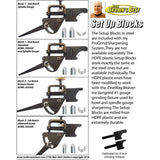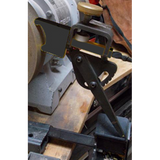Ron Brown's Best - Gouge Setup Jigs for Wolverine Sharpening Jig #1 & 8-inch grinding wheels
Designed For Use With Any Wood Lathe Sharpening Jig That Uses A Gouge Holding Fixture, i.e. VariGrind 1, Varigrind 2, Sharpfast, etc.
Although there are dozens of different bowl gouge grinds possible, there are really only 4 major shapes that most woodturners will ever use. Three are for bowl gouges and one is for a spindle gouge.
1) The Ellsworth style or Irish Grind - Use for wet wood and shear cuts and for taking heavy cuts in green wood.
2) Standard Grind - Use on dry wood, bowls rough turned and now dry, smaller vessels. Also sometimes more user-friendly for the inside of a bowl.
3) Bottom Feeder - A very blunt grind useful for finishing the inside bottom of a vessel. It is easier to rub the bevel across the bottom with this grind.
4) Fingernail Grind for Spindle Gouges. This grind makes it much easier to roll beads and scoop out coves especially on finials.
With these 4 grinds, there is almost no task you cannot accomplish.
Refer to the chart included in the instructions for the grind you wish to make. Pictured here is the setup for an Ellsworth type grind. Use the #2 block and adjust the leg down to the 5th notch (45 deg). Adjust the pocket arm until the setup block makes two firm points of contact. Easy as pie!
One of the keys to quick and consistent sharpening is being able to achieve the same settings each time. The projection of the gouge from the gouge holding fixture makes good use of a gauge block like the shop made one show here. You could just drill a hole in a board the correct depth (2")
You get all of this with comprehensive instructions in two simple to use blocks. They make sharpening quick, easy and repeatable. Resharpening a gouge shouldn't take any longer than 1 minute when you use these set up blocks.
-
Ellsworth Type Grind An Ellsworth Type Grind is a long grind with approximately 60 deg nose angle. The wings are pulled back further than on a standard grind. This shape is very useful especially on green wood when you want to take a very large shaving. Properly used, the long wings can also be used for shear cutting on the outside of a vessel. When shear cutting on the inside of a bowl, care must be taken to avoid catches.
-
Standard Bowl Gouge Grind This is the grind most bowl gouges come with. The nose angle is around 45 deg and the wings are fairly short. Most turners prefer this grind for dry wood, or rough turned bowls which are now dry. Much less aggressive shavings are normal with this grind. It is a useful grind for newer turners or whenever catches seem to be an issue. Bottom Feeder Grind It can be difficult to continue rubbing the bevel when leveling the bottom of a bowl. The bowl sides prevent the gouge from tilting over enough to engage the bevel. When you lose contact with the bevel, the gouge skips and results in an uneven cut.
-
The bottom feeder is a very blunt grind with a nose angle of around 75 deg. The wings should be ground almost straight like a spindle roughing gouge. In use, the gouge is held just perpendicular to the bottom and swept from left to right to the center of the bowl bottom. You can rub the bevel all the way across.
- Fingernail Spindle Gouge The fingernail spindle gouge grind is universal these days. If the wings are pulled back a bit more than normal, this grind is particularly helpful for rolling small beads and scooping out coves for finials, adornment on turned lidded boxes and any other spindle turning with exterior detail.




